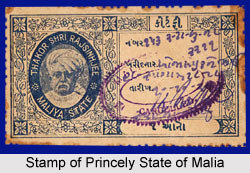 Princely State of Malia, also known as Maliya, was one of the significant princely states in India under the indirect rule of the British East India Company. The state was administered and supervised by the native ruler, also addressed as Indian Prince by the British authorities. Malia State was scattered over a total area of 103 sq miles the population of the princely state was 10,788 in the year 1941. The native state of Malia consisted of around 15 villages that were situated in the northwestern Kathiawar region. The territory was almost entirely enclosed by the princely state of Morvi and the northern enclaves of the state. Malia also shared a brief border with Kutch in the north and with the princely state of Dhrangadhra in the east. Another smaller enclave of Malia state, which lied towards the east of the core area, was bordered by a remote block of territory that belonged to the princely states of Morvi and Dhrangadhra.
Princely State of Malia, also known as Maliya, was one of the significant princely states in India under the indirect rule of the British East India Company. The state was administered and supervised by the native ruler, also addressed as Indian Prince by the British authorities. Malia State was scattered over a total area of 103 sq miles the population of the princely state was 10,788 in the year 1941. The native state of Malia consisted of around 15 villages that were situated in the northwestern Kathiawar region. The territory was almost entirely enclosed by the princely state of Morvi and the northern enclaves of the state. Malia also shared a brief border with Kutch in the north and with the princely state of Dhrangadhra in the east. Another smaller enclave of Malia state, which lied towards the east of the core area, was bordered by a remote block of territory that belonged to the princely states of Morvi and Dhrangadhra.
Location of Princely State of Malia
The erstwhile princely state of Malia was incorporated as a part of the Baroda Agency, which was a sub division of the Western India States Agency. Later, the territory was merged with the Indian state of Gujarat. The state was also under the administrative control of the Western Kathiawar Agency.
History of Princely State of Malia
The Jadeja Rajputs were the ruling family of the princely state of Malia. The family was an offshoot of the ruling family of Morvi branch. Modji, the founder of the state of Morvi, was the 6th son of Kayaji. He was granted the territory of Malia or Maliya, along with many other villages, as a prerogative during the initial part of the 18th century. Thus the ruling family and their successors were known as Kayanis. The succession of the throne or gadi of the native state was governed by the rule of male primogeniture, through which the first born or eldest child of the same parents inherited the entire estate of one or both parents, to the exclusion of all others.
The native ruler of the state of Malia, who held the title of Thakor, exercised substantial civil and criminal jurisdictional authority. He was in charge of the administrative functions of the state. The former princely state was ranked 37th in order of precedence among the states of Western India. The Princely State of Malia paid annual tribute to the princely state of Junagadh and the princely state of Baroda. The Thakor of Malia was one of the original constituent members of the Chamber of Princes, a number of smaller states indirectly represented by 12 princes who were elected periodically. The territory was attached to the princely state of Morvi under the Attachment Scheme of 1943. It was among the only 3 of 18 states that were attached in the 2nd phase of the scheme which cooperated with its attaching state.
Accession of Princely State of Malia
The last native ruler of the state of Malia or Maliya, who was the 10th of his line, acceded the princely state to the Dominion of India, also known as Union of India, after the country gained independence from the British rule and the Partition of India on 15th August 1947.



















